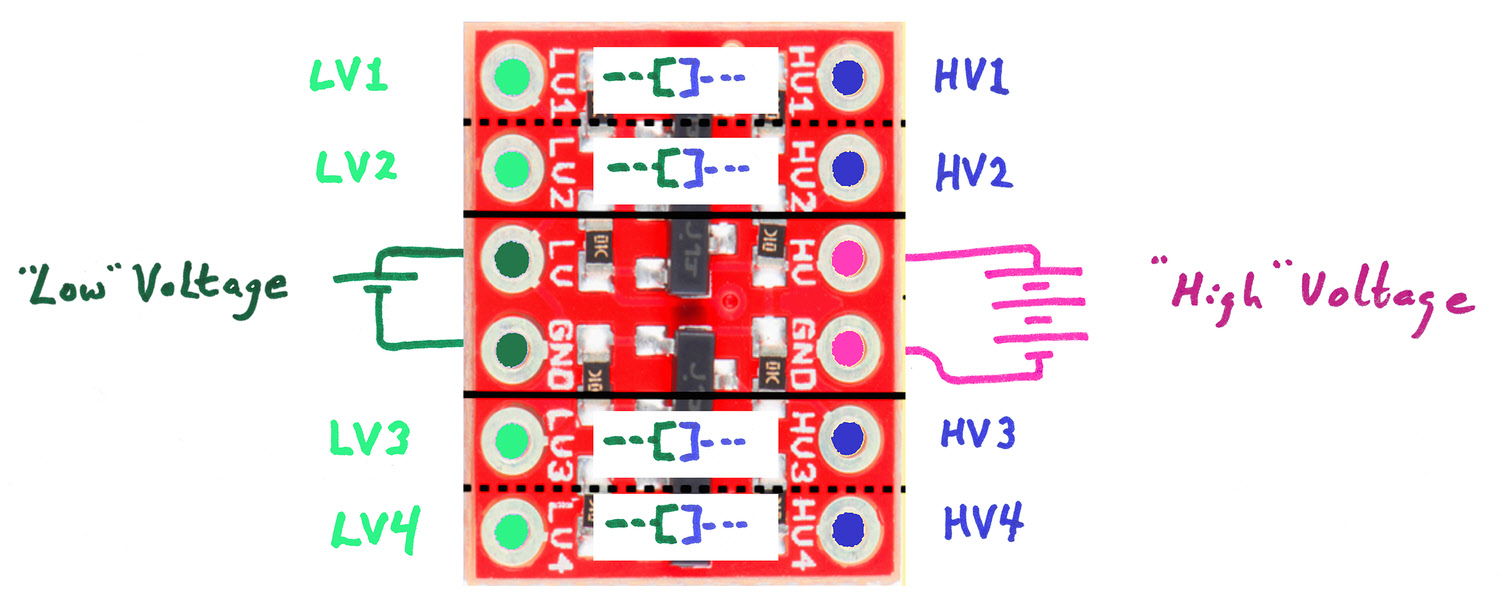Not a complicated device. Not a big page. But at least one of them useful.
The page you are reading speaks about the specifics of one $3 module that gives you three channels of 3v3 to 5v, or 5v to 3v3 levels. If you would like to look at the issues of different voltage levels a little more generally, I suggest my general introduction to voltage level shifting. It covers whys and wherefors, not just hows. It isn't a complex topic, but one you would be right to be wary of.
For many years, hobbyist electronics was mostly at the 5v level. More recently, there's been a move to working at 3.3v, also known as "3v3".
If, say, you are using a 3v3 Arduino, but want to drive a 5v LED matrix, what do you do?

The Sparkfun BOB-12009 is a simple answer, and costs $3. (1/19, excl p&p).
You hook up a source of 5v to the "High Voltage" pins... the 5v, and the associated ground.
You hook up 3v3 (and ground) to the "Low Voltage" pins.
Now you have four "paths" through the device. Connect 3v3 to "LV1", and you will have 5v at "HV1". If LV1 is connected to ground, HV1 will be connected to ground.
When I say "connect to 3v3 to LV1" or "connect it to ground", I of course mean to imply that you could equally well drive it high or low with the output of some electronics.
But! You can use any channel either way... connect HV1 to 5v, and 3v3 will pre present on LV1.
As even, you wouldn't want to connect an output to an output... i.e. you wouldn't, on a given channel, connect voltages, or output pins from other electronics, to both sides of the channel at the same time.
You can use the channels independently, though... channels 1 to 3 could be connected to voltages on the LV side, to create voltages on the HV side at the same time as channel 4 was "passing messages" the "other way": It could be connecting to voltages on the HV side, to create voltages on the LV side.
This device is meant for translating the voltage of digital signals. The output should not be expected to source or sink significant current.
The general idea of these pages is it make it easier for you to use some little gizmo that I found fun. I hope this one achieved that? Your thoughts and anecdotes, welcome. What are you using one of the devices discussed here for? Virtues? Problems? (Especially anything not mentioned above that you think the next person reading this would like to be told.)
If you found this of interest, please mention in forums, give it a Facebook "like" or "share"? I've almost given up writing these pages, because it seems they are seldom read, and of course not every reader will use them... so... is there any point? If you want more of this stuff, help!?
Click here to visit my main homepage where you
can explore other areas, such as education, programming, investing.
![]() Page tested for compliance with INDUSTRY (not MS-only) standards, using the free, publicly accessible validator at validator.w3.org. Mostly passes.
Page tested for compliance with INDUSTRY (not MS-only) standards, using the free, publicly accessible validator at validator.w3.org. Mostly passes.
....... P a g e . . . E n d s .....